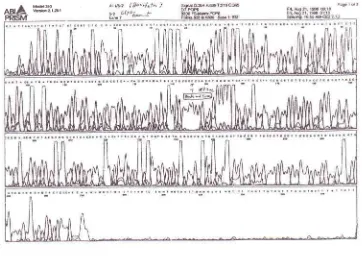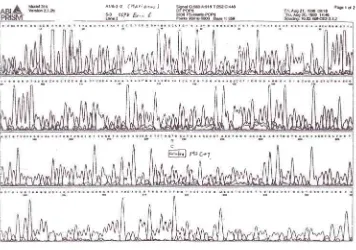--!
2I0
Hardjowasito et al Med J IndonesIdentifïcation
of
point
mutations
in
Glucose-f-Phosphate Dehydrogenase
gene
in Timor
Island people
:
A preliminary
report
Widanto Hardjowasito*,
Bambang
oeki
EnggarFitri*, Mardhani
Ys*,Loekito R.M.,
Taku
Shirakawao,Kaoru
Nishiyam
Matsuo#Abstrak
Defisiensi enzim glukosa 6 fosfat dehidrogenase (G6PD) umumnya ditemukan di daerah endemis malaria, namun sampai sekarang
tiiak
ada
satupin
penelitiàn tentang dasar molekuler defisiensi G6PD di daerah Pulau Timor Indonesia yang merupakan daerah hiperendemik malaria dengan mayoritas pendudukdari
ras Proto Malay. (Jntuk mengetahui frekuensi dan tipe mutasi secara m'olekuler, seratus delapanTelas penduduk asli Timor diperil<sa menggunakan tes Formazan ring untuk penentuan defisiensi G6PD. Mutasi pada G6PD gene ditentukan dengan metode MPTP ( Multiple PCR Using Multiple Tandem Forward primers and (t common reserveprimer) dan
konrtrmasi dilakuknn dengan automatic sequencer. Tiga penduduk laki-Iaki menunjukkan aktivitas G6PD yang rendah dan denganMpTp
dua di
antaranya menunjukknn adanya mutasi noktah. Sekuensingdari
dua knsus tersebut berhasil mendeteksi adaiyo mutasi pada T3B3C pada exon 5 dan C592T pada exon 6. Kesimpulan dari penelitian ini adalah telah ditemukan mutasi noktah pada exon 5 don"ron
6 dari gen G6PD penderita ras Proto Malay. Dua jenis mutasi ini merupakan mutasi yangumum ditemukan di daerah Asia. (Meil J Indones 2007;
I0:
210-3)Abstract
Glucose 6 phosphate dehydrogenase (G6PD) deficiency
is
common in malaria endemic region, however no molecular study has been performed onèoro
d"trri"niy
in Timor Island, Indonesiai a malaria! hyperendemic area which Proto Malay is the majority of the 'peàplein that island.
io
obrrrv"
thefrequency and molecular type of mutations in G6PD deficient Proto Malay people,l18
native'p"ipl"
*"r"
screened using formazan- rin'g tesi. Mutation in the G6PD gene were determined by MPTP (Multiple PCR using Multiple Tandem Forward
pimers
and a common Resert,e Pimer) method and confirmed by automatic sequencer. This study shows that three males have lowerG6pD
activity. Using MPTP method, a point mutetion could be indicatedin
the tvvo cases. Sequencingof
the amplified products in 2 G6pD pàtients âisctosed mutations of 7383C in exon 5and C
592 T in exon 6 in respective case. Our result documenti point mutations in exon 5 and exon 6 in the G6PD gene of two Proto Malay people in Timor. These mutations are common in Asia region. (Med J Ind.ones 2001; 10: 210-3)Keywords: mutations, G6PD, Proto Malay.
Glucose 6 Phosphate Dehydrogenase (G6PD) deficiency, an
X
chromosome
linked
hereditary enzymopathy,
isthe most coïnmon red
cell
abnormality
of
humans.lThis
diseaseentity
is
causedby
theinheritance
of
anyof
large number
of
abnormal alleles
of
the
gene*
Congenital Anomalies and Growth Studies Section, Biomedical Research Center, Medical Facuky, Brawijaya University, Malang, Indonesia
"
Faculty of Health Science, Kobe University School of Medicine, Tomogaola, Suma, Kobe, Japano
Division of Genetics,.Intemational Centerfor
Medicalr e s ear ch, Ko b e (J niv er s ity, S c ho o I of M e dicin e, Kusuno ki c ho,
Chuo, Kobe, Japan
responsible
for
the
synthesisof
the G6PD
molecule.Majoriry
of G6PD deficient individuals are a$/rnptomaticbut
exposureto
fava
beans,certain drugs such
as theanti malarial drug like primaquin
and
infections
maytrigger
avariety of
clinical
manifestation ranging
from
acute
hemolytic
anaemia
to
severe
chronic
spherocytic hemolytic
anaemia.z'3It
is a
glo
important
causeof
neonataljaundice
and
causeslife-threatening hemolysis crisis
in
children.
It
is
common
in
Mediterranean,
African and
some
East
Asian
on but
rare
in
Korea.
Only
four
cases
of
eficient
have beenfirst
noticed
in
Korea.aIn
addition,
many casesof
silent mutations
in
the geneVol 10, No 4, October
-
December 2001except
somedeietions
of
3 or 9
bases aresingle
basesubstitutions
in
the
coding region.
There
is
evidencethat
the high
frequencies
of
deficient alleles
havearisen because
they
cover
a
selective
advantage against malaria.5Several studies
on
frequency
andthe
genetic basisof
G6PD deficiency among
the
Deutro lvlalay
racial
group are
published.6
However,
no
information
isavailable
for
the Proto Malay racial group
living
in
East Nusa Tenggara
Timur
Province
of
Indonesia(NTT)
wheremalaria is
still highly
endemic.To
facilitate clarification
of
the molecular basis of
G6PD deficiency,
Shirakawa
et
al7has developed
amultiplex
PCR
method usingmultiple
tandemforward
pri
rs and a common reverseprimer (MPTP
method).This
simple method facilitates molecular study of
G6PD deficiency, especially
in
developing countries.The aim
of this
study
is
observeto
thefrequency
andmolecular type
of
mutations
in
G6PD deficient Proto
Malay
people. One hundred eighteen native
ProtoMalay people were
screenedusing
formazanring
test.Two
unrelated patients
of
G6PD deficiency
were'
studied
for its
nucleotide
changein
exons
5
and6 of
the G6PD
geneby MPTP.
Here,
we
demonstratetwo
mutations
T383C and C592T
of
the G6PD
gene
in
Proto
Malay
Indonesians.METHODS
Blood
samples
from
118
independent
Proto
Malay
were randomly collected on
filter in July
1998in
subdistrict
Insana,
district
Kefamenanu,
Timor
Island,Province of
Nusa TenggaraTimur.
G6PD deficiency was
screenedby
using the Formazanring
method .Mutation scanning
wasperfo
d
in
themethod.
Ten microlitres
of
solution
contailing
8pl
of
rnaster
mixture
(10mM
Tris-HCl,
pH
8,3;
10mM
KCI;
250
umM
dNTPs;
2,5 rtÙl MgCl2
dan 5VoDMSO),
I
ul
of
the
primer
mixture,
I
pl
of
the
enzymemixture
(0,9
pl
of
distilled water
and0,1
pl
of
5
U Ampli
taqDNA
PolymeraseStoffel
FragmentPerkin
Elmer
Co,USA)
were
preheatedto
85oC.PCR
wasthen
canied
out
with
the
following
cycles
: 25
cyclesat
95oC and72oC
aîd
OoCfor
30 second each. The products wereMutations in G6PD gene in Timor islnnd
people Zll
run
in
4Vo agarose gel electrophoresis (l\4etaPhor/ SeakenHGT
3:1) containing 0,5
pglml
ethidium bromide
andthe gels were photographed using a
LfV
ffansluminator.All
exonsof
theG6PD
gene were thenamplified
from
DNA
samples and was subjectedto
direct
sequencingusing
a
dye terminator
kit
(Perkin Elmer
Co),
anautomatic
DNA
sequencer(Ats PRISM
310),
Genetic Analyser (Perkin-Elmer Co).RESTILT
G6PD
deficiency
is
common
in
malaria
endemicregions and
is
estimated
to
affect upwards
of
400
million
people world-wide.
To
date,
more than
300different G6PD
variants have been distinguished
onthe
basis
of
biochemical
parameters, suggesting
avast genetic heterogeneity.l So
far,
however,
only
asmall
portion of this
heterogeneity has beenconfirmed
at the
DNA
level
through the
identification
of
about 60different mutations
in
theG6PD coding
sequence.sA
mutantG6PD
enzyme may bedifferent
from
personto
person,
mutation can
be
in
the
form
of
point
mutation or
can range
from
one
to
several
basepair
deletions as
well
as replacementsin
theDNA.e Different
populations have
different types
of
mutations,
but
within a specific population, corlmon
mutations
areusually
shared.In
SoutheastAsia
mutation
in
exon
5,6 and 9 are coûrmon.
Two
patients
with
G6PD
deficiency
and
onepatient
with low
enzyme
activity
were
detected
from
118Proto
Malay individuals by theformazan
ring test.We
examined
mutations
in
exon
5
and
exon
6 of
theG6PD
genein two
patients. Onepatient
wasfound
to have a T> C substitution
atnucleotide
position
383in
exon 5 (Fig
1).This mutation
correspondsto
thevariant G6PD Banks
and Torres (Vanua lava).
The
other patient wasfound
to have a C>
T
substitution in
exon
6
atposition
592
and correspondsto the
variantCoimbra (Ftg
2)
respectively. These substitutions wereconfirmed
by
the nucleotide
sequencing
procedure.However, we could not identify any mutation
in
the patientwith low
enzymeactivity.
DISCUSSION
Our
result
indicated
that mutation
screeningin
thelimiûed number
of
exons
of
the
G6PD
gene
has212
Hardjowasito et alIndonesians,
even though Proto
Malay has
beenconsidered as an isolated population
in
theNTT
region.This suggested that Proto Malay is not isolated but mixed
up with
other Indonesian, sinceboth G6PD
Banks andTorres (Vanua
Lava)
andG6PD
Coimbra have
beenidentified
in
other partsof
Indonesia. However,it
needsfurther
study
to
get
a
conclusion.
G6PD Coimbra
isincluded
in
the
"Mediterranean
Type" which
arecharacterized
by
decreasedMichaelis
constant(Km) for
both G6P and
NADP
andlow
substate specificity.r0Our result
showed that
MPTP scanning
mutation in
exons
5
and
6
areuseful to characterized
molecular
background
in
Proto Malay G6PD deficiency.
Theusefulness has
been confirmed
not only
in
Singaporebut
also
in
Philippines.tt'tt
Since
MPTP
needs only
PCR
machine,
this
technique
could be
employed
in
South East
Asia
countries
to
characteized
mutations.Another method
using
SSCP
(Single-StrandConformation
and
alysis)
had been used toidentify
genetic
in
Calabria.r3Among
118Proto
Malay
Indonesiansin Timor
Island,two
males were
found to
have
apoint
mutation.
Oneof
them has apoint
mutation
in
exon
5 conespondi,ngMed J Indones
to
thevariant G6PD
Banks and Torres
andthe
otherin
exon 6 correspondingto
thevariant Coimbra.
Further studies are planned
in
the same region this year.A
bigger population would
be investigated,which
also includes malaria cases. The needfor utilizing
screeningmeasures
for
early
detection
of
the
genetic defect
isimmediately
apparent,once consideration
is
taken
of
the
high probabiliry
of
associationof
G6PD deficiency
with
other
hemoglobinopathies,
such
as
sickle
cell
anaemia,
which may lead
to
amore
seriouscondition.
In
addition,
thereis
acompelling
needfor
introducing
measures such as genetic counselling and
public
healtheducation
as part
of
the overall health and
welfare
services
in
the area.Acknowledgement
We
gratefully
acknowledge
the
permission
andencouragement
from Dr
BambangPurnomo, Kakanwil
Kesehatan
RI
Plopinsi
NTT, Drs Anton
Amaunut'
Bupati
KDH TTU
andDr
Valentinus
Parrera Kadinkes [image:3.612.117.479.428.689.2]TTU
PropinsiNTT,
for
this stirdy.Figure
I.
Sequencing of one patient with G6pD deficiency. He was found to have a T > C substitution at nucleotide position 383 in exon 5. This
mutation corresponds to the
vaiant
G6PD Banks and Torres (vanua lava).Fg.A
Vol 10, No 4, October
-
December 2001 Mutations in G6PD gene in Timor islandpeople
Zl3
Attæ2 ( 4il; 04" ) wegrgràræcqDlffi
@rt
@ffi PfuÉb@ b
[image:4.612.105.461.95.345.2]F',l,,f, v1tç-1
Figure 2.
Sequencing of one patient with G6PD deficiency. He was found
with
a C > T substitution in exon 6 at position 592 and colTespondsto the variant Coimbra.
REFERENCES
1.
Beutler E. G6PD dehciency. Blood 1994; 84: 3613-36.2.
BeutlerE, Kuhl W.
The
NT
l3ll
Polymorphismof
G6PD: G6PD
Mediterraneanmutation
may
haveoriginated independently in Europe and Asia. Am J Hum Genet 1990', 4'l :1008-12.
3.
MasonP.
New
insight
into
G6PD deficiency.Br
JHaematol 1996 ; 94:585-91.
4.
Kim M.K.,
Yang-CH,
Kang
S.H.,Lyu-CJ, Kim-KY. Glucose-6
phosphate dehydrogenase deficiency-reportof
4 cases. J Korean Med Sci.l992;7(1):71-5.
5.
RuwendeC,
Khoo SC, Snow RW. Natural selectionof
hemi- and heterozygotes for G6PD deficiency in Africa by
resistance to severe malaria, Nature, 1995:376:246-49
6.
Rovira A, Vulliamy TJ, Pujades MA, Luzzatto L, CononsJLV. The Glucose- 6 phosphatase dehydrogenase (G6PD) deficient variant G6PD union (454 Arg-Cys) has
aworld-wide
distribution possibly dueto
recurrent mutation. Human Mol. Gen. 1994;3 633-835.7.
ShirakawaT,
Nishiyama K, Lai Poh-San, MatsuoM.
Acomprehensive Method to scan for point mutation of the
Glucose
6
Phosphatase Dehydrogenase. JpnJ
Human Genet 1997; 42:417-23.Ganczakowski
M,
TownM,
Bowden DK,Vulliamy TJ,Kaneko A, Clegg JB, Weatherall DJ, Luzzato
L.
Multipleglucose-6-phosphate dehydrogenase
deficient
variants correlate with.malaria endemicity in Vanuatu Archipelago (Southwestem pacific). Am JHum
Genet 1995;56:294-301.
Scriver CR. Glucose-Gphosphate Dehydrogenase Deficiency. In: The metabolic and molecular bases of inheritd disease.
195; McGraw- Hill 7ft edition: 3367-98.
Corcoran CM, Calabro V, Tamagnini G, Town M, Haidar
B,
Vulliamy
TJ,
Mason
PJ,
LuzzatoL.
Molecularheterogeneity
underllng
the
G6PD
Mediterranean phenotype. Hum Genet 1992; 88: 688-90Fujii H,
TakahashiK,
Miwa S.A
new simple screening method for glucose-6-phosphatase dehydrogenase deficiency,Acta Haematol Jpn i984; 47:185-8
Hsia YE, Miyakama F, Baltazar L. Frequency of Glucose-6-phosphate dehydrogenase defi ciency (G6PD) mutation
in
Chinese, Filipinos, and Laotians from Hawaii. Jpn JHuman Genet 1993; 92:47A-76.
Calabro v, Mason PI,
Filosa
SD. Genetic heterogeneityof Glucose-6-phosphate dehydrogenase defi ciency revealed
by single-strand conformation and sequence analysis, Am
J Hum Genet 1993,52:527-36.
8
9
t0
ll
t2.

